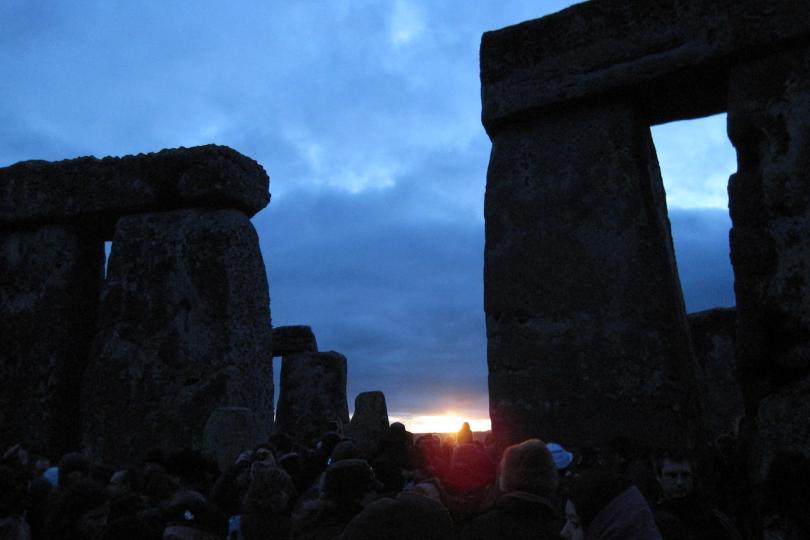Is it old? Is it Christmas?

We made our way through the cold winter night into a glen of standing stones. Snow swirled across the ground, while a row of trees rose up into the darkness beyond. A glimmer of starlight illuminated the bare branches above. And while we weren’t much warmer, at least we were out of the wind, and comforted by the scent of warm cider drifting over from the concession table.
My spouse and collaborator Amy walked over to the table and poured herself a cup of hot cider, as the actors practiced their fights onstage, preparing for that night's performance of A Midwinter Night's Revel. Meanwhile, outside the Red Eye Theater and below the horizon, the sun slowly edged back toward the Northern hemisphere.
Invented traditions and imagined pasts
I don't have many holiday traditions of my own. Being an only child of divorced parents, holidays were pretty informal affairs. By the time I became an adult I had no real family traditions. This gave me a chance to forge new traditions in the company of friends and loved ones. Seeing a weekend of holiday shows with an out of town friend. Driving to Chicago to reconnect over the Thanksgiving table. An annual hot beverage party. It was great to spend time with friends and loved ones, but these events still felt disconnected from any sense of history. That lack of connection still lingered over my activities. For what is tradition but a desire to somehow reclaim the past?
In winter of 2009, I was reading a book called Santa Claus: The Last of the Wild Men as research for S. Gunter Klaus and the Story Before, when I reached the chapter about English holiday myths and folklore, and was suddenly struck by series of images:
A young woman in fur walking through a snow-filled wood. Titania, Queen of the Fairies, bargaining for the life of an unborn child. A fat middle-aged Puck, disguised as a cockney tradesman. Oberon, the fairy king, enthroned upon a gnarled root encased in iron.
I was immediately seized by an overwhelming urge to build a show around these images. A sequel to A Midsummer Night’s Dream set in turn of the century England. But to find the heart of the show, it seemed vitally important that I understood that legends and traditions behind it.
Winter solstice 2011
We are standing at the center of Stonehenge next to a white-bearded fellow who introduces himself as Merlin.
Thanks to a Minnesota State Arts Board Artist Initiative Grant, Amy and I were in the midst of an epic quest across England to find find the earliest ritual and dramatic roots of Christmas. This particular morning, that meant driving several hours before dawn to Stonehenge, to greet the return of the sun among the stones.
“You know,” said Merlin, “You’ll get a better view if you climb onto that stone.”
With some uncertainty, we helped each other onto a flat horizontal slab, putting us a full head above the crowd. After this, Merlin calls out to us: “That’s the Altar stone. The most sacred place in Stonehenge. The only stone they haven’t excavated.”
As we climbed back off the stone and watched the rising sun crest the horizon, I couldn’t help but think about C.S. Lewis’ The Lion, The Witch, and the Wardrobe. Why are impossible other worlds and ancient magics such a prevalent part of our holiday folklore? Santa Claus at the North Pole. Scrooge and his time traveling ghosts in A Christmas Carol. Even the release of epic fantasy movies like The Lord of the Rings or the Harry Potter series.
Some religions claim that the boundaries between the worlds is thinner at this time of year. Our traditions certainly help make the legendary past feel closer. After all, this is when we still teach our children to believe in elves.
Is it old? Is it Christmas?
When you step into an alternate world, you never know what’s going to happen. That’s kind of how it felt as we traveled through England that holiday season. We had two criteria for anything we did: Is it old? Is it Christmas? The answers to those questions brought us to many places that inspired fantasy and legend: A foggy train station in the Yorkshire moors; a cemetery in Whitby high over the northern sea; Shakespeare’s boyhood home; the Eagle and Child Pub where luminaries like J.R.R. Tolkien and C.S. Lewis once met; the colleges of Oxford; a lantern parade in Brighton; Glastonbury Tor; Chalice Well; the Roman Baths; the streets of London. And of course, Stonehenge.
In such places where history, prehistory, and myth all convene, it becomes difficult to separate legend from fact. Maybe it doesn’t matter. Ultimately, these places have meaning because we have chosen to give them meaning. And yet the more I learned about the places I went and the legends surrounding them, the more difficult it became to hold onto my initial inspiration.
Making Christmas, Making Christmas, la la la!
Inspiration is a gift, but it’s also a curse. It’s easy to get attached to those early ideas.
As we traveled, the work changed. It took unexpected turns, characters were added or cut, new themes emerged, and themes that I thought were important disappeared. By the end of the process, it was quite a different work than the one I set out to write. Eventually, all the images that originally inspired me no longer had a place in the work. But what came in their place was stronger, better connected, and more genuine.
That’s also how it is with traditions. We create legends and traditions to give ourselves a sense of order in an uncertain world. So it becomes doubly important to reclaim or invent traditions that add meaning to our lives. The ideas that remain are the ones that grow and change along with us. They will endure as long as they still connect with us. And if they don’t, it’s okay to release them and move on.
One hundred years to the day
On December 21st, 2015, Amy and I stood together in the Red Eye Theatre. Papercut snowflakes filled the lobby and the smell of mulled cider wafted through the room, while the actors warmed up onstage. “Did you realize,” she said “That this performance is exactly one hundred years after the play?”
A Midwinter Night's Revel wasn’t anything like the story I set out to write. But it’s the story that felt right. This new script is endowed with deep experience, layers of myth, and a sense of discovery. And the spirit of the original is still there, as Puck, Oberon, and Titania interfere with mortals in the English woods on midwinter night 1915. Exactly one hundred years before that performance, to the day. Sure, it was a fiction. But after the journey of making the play, that connection to the past didn’t feel any less significant.




